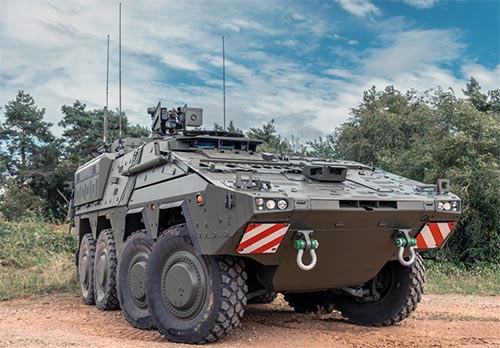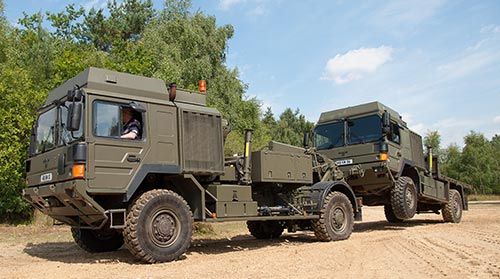Modern warfare demands more from military vehicles than ever before. Whether it’s enhanced protection, advanced weapon systems, or modular adaptability, today’s platforms are larger, heavier, and more complex. As vehicle capability increases, recovery systems must evolve to match – not just in strength, but in mobility, adaptability and compliance.
Wheeled platforms like the Boxer Mechanised Infantry Vehicle, Archer 155 Artillery System, and the TYRO Bridging System present significant new challenges for military recovery. With greater weight comes greater complexity – and with that, increased risk. Not just to the vehicles themselves or the crews tasked with recovering them, but also to mission efficiency, operating costs, and long-term fleet resilience. These challenges don’t just affect the platforms being recovered – they extend to the recovery assets themselves, which must now operate closer to the limits of their own capability.
EKA’s Programme Manager, Joe Whittaker, puts it plainly:
“These vehicles are no longer concepts – Boxer, Archer and Tyro are already in production or entering service. They’re heavier, more advanced – but their recovery hasn’t been designed in parallel. It’s a critical gap that the MOD now needs to address, and industry has a key role to play in helping shape the solution before it becomes a frontline problem.”
Joe brings extensive frontline expertise to his role, having served as a Recovery Mechanic Senior NCO and Class 1 Recovery Mechanic in the Army Reserves for over 15 years.
When weight becomes the risk
Mobility is the cornerstone of effective recovery. The ability to reach, secure, and extract a vehicle from degraded infrastructure or hostile terrain is essential. Yet today’s military recovery crews are increasingly operating at the very limit of their equipment’s capacity.

Joe explains that many of the newest platforms in service were not designed with recovery in mind – at least, not to the level required for current conditions. Recovery, in some cases, became an afterthought – a gap that now needs urgent attention.
Each of these vehicles presents a unique challenge:
- Boxer MIV: Boxer’s design does not lend itself to traditional recovery methods, as the rear tyres and axles are not rated to support the vehicle’s total weight. Flat tow is currently the only recognised recovery method.
- Archer 155 Artillery System: This vehicle articulates in the middle and is mounted on an unconventional chassis, making traditional recovery techniques difficult or impossible without OEM engagement.
- TYRO Bridging System: Still to enter service but already raising concerns due to its heavy overhang and concentrated rear load, which makes stable lifting difficult and places considerable stress on both casualty and recovery vehicles.
“If we don’t solve this now, the knock-on effect is time, complexity, and risk,” Joe said. “You’re sending people into vulnerable situations with equipment that’s already working at the limit. That’s not acceptable – operationally, financially, or morally.”
Why building bigger isn’t the answer
Faced with heavier platforms, one response might be to build a more powerful recovery vehicle. But that brings its own problems.
Every additional feature – a larger crane, more powerful winches, heavier lifting gear – increases the recovery vehicle’s own weight. That has a direct impact on its compliance with UK legislation, specifically under the Special Types General Order (STGO) regulations and EU / Country specific road regulations:
- STGO Category 1 allows a combined vehicle weight of up to 50 tonnes
- STGO Category 2 increases this to 80 tonnes
- STGO Category 3 allows up to 150 tonnes, but with serious operational constraints, including restricted routing, mandatory police notifications, escort vehicles and reduced speeds
Modern armoured vehicles like Boxer already weigh over 38 tonnes. Paired with a 30-tonne recovery vehicle, the operation is instantly approaching Category 2 limits – even before any lifting occurs. Push further, and the mission risks slipping into Category 3 territory, with all the delays and costs that come with it.
These weight thresholds were not designed with modern military recovery scenarios in mind – particularly where systems like suspend tow are involved. In these cases, the recovery vehicle is not carrying a payload in the conventional sense but is instead supporting mobility and extraction.
While STGO is essential for regulating peacetime road use in the UK, its current structure presents clear limitations for military recovery operations – especially during training. The same applies across Europe, where country-specific road regulations create further layers of complexity.
This raises an important question: do existing frameworks allow recovery vehicles to operate as effectively as they need to in today’s defence environment?
“You can’t just build a recovery vehicle that can lift anything,” said EKA Managing Director Michael Keach. “Because if it then needs its own escort and a specially planned route just to reach the casualty, you’ve already lost time and tactical advantage. In wartime, some of those constraints may be lifted – but in peacetime, they limit how and where the vehicle can be used, particularly during training exercises. That’s not support – that’s a liability.”
The physics problem: when recovery vehicles can’t overmatch their casualty
In military recovery, some principles are non-negotiable. One of the most fundamental is that a recovery vehicle must outweigh the casualty it’s attempting to move – particularly if the casualty is unbraked or unable to assist in its own extraction. This isn’t a preference or best practice. It’s physics. Mass equals control.
When a casualty vehicle can’t provide braking or resistance, the recovery platform must dominate in terms of weight and traction to ensure stability and safety – especially off-road, in combat zones, or across uneven terrain. But this basic requirement is becoming harder to meet.
Modern military platforms are getting bigger, heavier, and more complex – thanks to hybrid propulsion, advanced armour, and modular systems. Recovery vehicles, however, are not always scaling at the same rate. In some cases, the recovery asset may now be equal to – or even lighter than – the casualty it’s expected to move.
“The physics haven’t changed – but the vehicles have,” said Michael Keach. “We’re now reaching a point where overmatch isn’t guaranteed, and that puts recovery crews in a far more vulnerable position. It’s why we need recovery solutions that match the reality on the ground – not just the ideal on paper.”
The result is a growing mismatch between what recovery crews are expected to do and what they are physically able to achieve. Without the necessary weight advantage, traditional methods become harder to execute safely – and in some situations, unworkable. This increases the risk to both equipment and personnel, and further reinforces the need for lighter, more adaptable recovery systems that maximise performance without compromising physics.
The one-size-fits-all recovery truck is no longer fit for purpose
In recent years, the military has favoured multipurpose recovery trucks – platforms that carry everything needed for lifting, winching, towing and stabilisation. But the increasing size and weight of both vehicles and equipment now make that approach counterproductive.
Joe put it clearly: “Every time you add a feature – a crane, a more capable winch, more control systems – you reduce the effective payload. It’s not just about what you can lift, it’s about what you’re left with in terms of operational headroom within the capability of the chosen chassis. Something’s got to give.”
That’s why EKA is applying serious consideration to a systematic approach to recovery. Each component is purpose-built to handle its part of the operation efficiently, without carrying unnecessary weight or overcomplicating the platform.
Joe added: “Recovery, it’s about designing smart, specialist vehicles that can work together in any scenario – and stay compliant while doing it.”
The case for suspend tow – more relevant than ever
In a previous article, we explored why suspend tow is a battlefield-ready alternative to bulky underlift systems. It’s faster to deploy, more terrain-agile, and places less stress on the recovery vehicle. Now, in the context of rising weights and tighter legislative constraints, its advantages are even more pronounced.
“Suspend tow has a lower system weight,” Michael said. “That means we’re not eating into the axle weight limit before we’ve even picked anything up. It gives us space – not just in terms of load, but in terms of flexibility.”
Suspend tow systems also reduce wear and tear on the recovery vehicle, improving long-term reliability and reducing whole-life costs. As axle loads increase and terrain becomes more demanding, this efficiency becomes an operational asset in its own right.
Designing for compromise – and capability
EKA is responding with real-world solutions. At one end of the spectrum is a lightweight recovery vehicle prototype, built on a Unimog chassis. At the other is a heavyweight recovery concept, under active development, using 8×8 and 10×10 chassis options to tailor capability to mission need.
“We’ve been working on this programme for over five years,” Michael said. “The last three years have been especially focused – we’ve completed design studies, selected preferred configurations, and worked closely with trusted industry partners like Rotzler (winches) and Atlas (cranes).”
Michael continued: “Crucially, EKA isn’t waiting on a formal instruction. The development was launched proactively, in response to an MoD press release that signalled a need for innovation across the recovery landscape. EKA took that as a call to act – investing in solutions ahead of demand.”
No global answer – but an opportunity to lead
Despite the size of the challenge, no current global platform has solved the issue entirely. Through international trials and NATO-aligned events, EKA has gained valuable insight into the global recovery landscape. These exercises have reinforced the importance of balance – between capability, mobility, and compliance. In this context, SV(R) continues to be regarded as a well-rounded and proven system, with performance characteristics that remain highly competitive in complex operating environments.
“We’ve tested SV(R) against others, and it consistently comes out on top,” Michael said. “It’s not about having the biggest crane or the largest winch – it’s about designing with intent. That’s the principle guiding everything we’re doing now. The aim is not to repeat SV(R) at scale – but to build on it, refine it, and evolve it to meet the demands of the next decade.”
Mobility matters more than ever
As military vehicles grow in weight and complexity, recovery systems must evolve too. Bigger isn’t always better – especially when it reduces access, increases cost, and compromises the mission’s efficiency.
Instead, the future of military recovery lies in scalable, compliant, modular solutions that work together – keeping forces mobile, efficient, and mission-ready.
EKA is not waiting. Development is already underway – rooted in reality, built for battlefield conditions, and ready to meet the needs of tomorrow.
“Mobility is the mission,” Michael concluded. “And recovery has to keep up – or the whole operation slows down. We’re designing systems that work in the real world, with real weights, real limits, and real missions in mind.”





